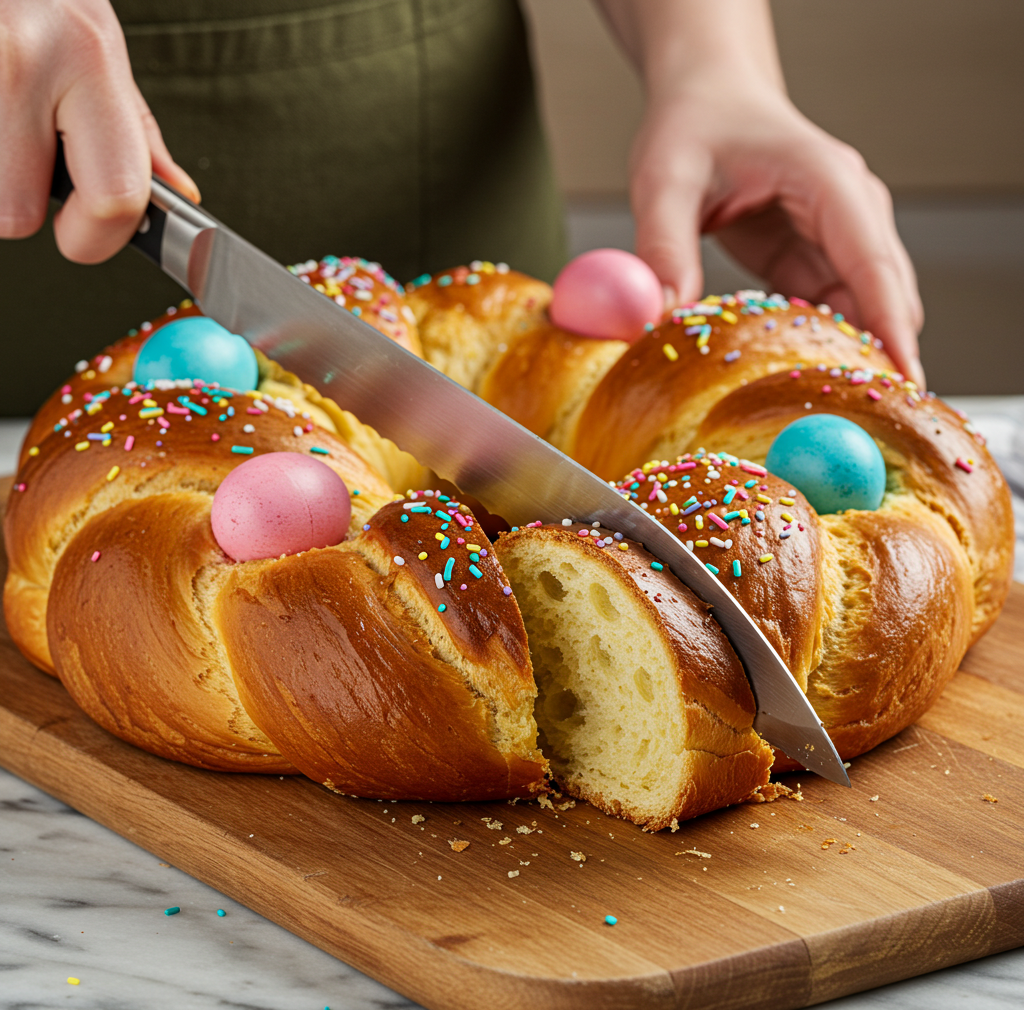Easter is a time of joy, celebration, and, of course, delicious food! Among the many festive treats, Easter Bread holds a special place in many cultures. This soft, slightly sweet, and beautifully braided bread is often decorated with colorful eggs and enjoyed as a centerpiece of Easter brunch.
In this article, we’ll explore the history of Easter Bread, its variations, and a step-by-step guide to making this delightful treat at home. Whether you’re baking for tradition or simply looking for a delicious homemade bread recipe, this guide has you covered.
What is Easter Bread?
Origins and Symbolism
Easter Bread is a traditional baked good associated with Easter celebrations across different cultures. It symbolizes renewal, prosperity, and the joy of Easter. The braiding of the dough often represents the Holy Trinity, while the eggs, a common decoration, symbolize new life.
Cultural Variations
- Italy – Pane di Pasqua, a sweet bread often braided with whole eggs baked into it.
- Greece – Tsoureki, a slightly spiced bread with a chewy texture, often flavored with mahleb and mastic.
- Russia – Kulich, a tall, rich bread glazed with icing and topped with sprinkles.
- Portugal – Folar de Páscoa, a rustic bread often made with cinnamon and anise.
Each country has its unique twist on Easter Bread, but they all share a common theme of celebrating Easter with a delicious homemade loaf.
Ingredients for Classic Easter Bread
Basic Ingredients:
- 4 cups all-purpose flour
- 1 packet (2 ¼ tsp) active dry yeast
- ½ cup warm milk (110°F or 45°C)
- ½ cup sugar
- ¼ cup unsalted butter, softened
- 2 large eggs
- 1 tsp vanilla extract
- ½ tsp salt
Optional Additions for Extra Flavor:
- 1 tsp orange zest or lemon zest
- ½ tsp ground cinnamon
- ¼ cup raisins or dried fruit
- ½ cup chopped nuts
These ingredients come together to create a soft, slightly sweet bread with a tender crumb and a delightful aroma.
Step-by-Step Instructions to Make Easter Bread
1. Preparing the Dough
- Activate the Yeast – In a small bowl, dissolve the yeast in warm milk and let it sit for 5–10 minutes until frothy.
- Mix the Ingredients – In a large mixing bowl, combine flour, sugar, and salt. Add the yeast mixture, eggs, vanilla extract, and butter.
2. Kneading and Rising Process
- Knead the Dough – Transfer the dough onto a lightly floured surface and knead for about 8–10 minutes until smooth and elastic.
- First Rise – Place the dough in a greased bowl, cover it with a kitchen towel, and let it rise in a warm place for 1–2 hours, or until doubled in size.
3. Shaping the Bread
- Divide the Dough – Punch down the risen dough and divide it into three equal parts.
- Braid the Dough – Roll each portion into long ropes and braid them together, tucking the ends underneath.
Decorating and Baking the Easter Bread
Traditional Toppings and Decorations
- Whole dyed Easter eggs
- Sesame seeds or pearl sugar
- Almond flakes
Baking the Bread
- Preheat oven to 350°F (175°C).
- Brush the braided dough with an egg wash (1 egg + 1 tbsp milk).
- Bake for 25–30 minutes or until golden brown.
- Let it cool before serving.
Different Variations of Easter Bread Across Cultures
Italian Easter Bread (Pane di Pasqua)
A sweet, enriched dough braided with colorful Easter eggs baked into it.
Greek Tsoureki
A spiced, slightly chewy bread made with mahleb and mastic, often served with a red egg in the center.
Russian Kulich
A tall, cylindrical bread topped with a sugar glaze and sprinkles.
Serving Suggestions for Easter Bread
- With Butter and Jam – Perfect for breakfast.
- Toasted with Honey – Enhances the sweetness.
- Paired with Coffee or Tea – A great afternoon snack.
- Used in Bread Pudding – A delicious way to use leftovers.
Common Mistakes and How to Avoid Them
- Dough Too Dry or Too Wet – Adjust with small amounts of flour or milk.
- Bread Didn’t Rise Properly – Ensure the yeast is fresh and the environment is warm.
- Overbaked or Undercooked – Use an oven thermometer for accuracy.
Storing and Preserving Easter Bread
- Store in an airtight container at room temperature for up to 3 days.
- Freeze for up to 3 months—wrap in plastic and then in foil.
- Reheat in the oven at 300°F (150°C) for a few minutes to refresh.
Conclusion
Easter Bread is more than just a delicious treat—it’s a beautiful tradition that brings family and friends together. Whether you’re continuing a long-standing custom or trying it for the first time, this recipe will help you create a soft, slightly sweet, and perfectly braided loaf that everyone will love.
From its rich history to its symbolic decorations, Easter Bread represents renewal, joy, and togetherness. With simple ingredients and step-by-step instructions, you can bake this festive bread at home and make your Easter celebrations even more special.
So, gather your ingredients, enjoy the process, and share this homemade Easter Bread with your loved ones. Happy Easter and happy baking!
Frequently Asked Questions (FAQs)
1. Can I make Easter Bread without eggs?
Yes! Substitute eggs with applesauce or yogurt for a softer texture.
2. How do I make gluten-free Easter Bread?
Use a 1:1 gluten-free flour blend and add an extra egg for better texture.
3. Why did my bread turn out too dense?
Overkneading or not allowing enough rising time can cause density issues.
4. Can I make Easter Bread ahead of time?
Yes, prepare the dough the night before, refrigerate it, and bake it fresh in the morning.
5. What’s the best way to dye the eggs for decoration?
Use food coloring or natural dyes like beet juice for vibrant colors.
Print
Homemade Easter Bread Recipe
- Total Time: 2 hours 30 minutes
- Yield: 1 large loaf 1x
Description
Easter Bread is a delightful, soft, and slightly sweet bread traditionally enjoyed during Easter. This homemade recipe features a rich dough, a beautifully braided shape, and optional festive decorations like dyed eggs or sugar toppings.
Ingredients
For the Dough:
4 cups all-purpose flour
1 packet (2 ¼ tsp) active dry yeast
½ cup warm milk (110°F or 45°C)
½ cup sugar
¼ cup unsalted butter, softened
2 large eggs
1 tsp vanilla extract
½ tsp salt
Optional Additions:
1 tsp orange or lemon zest
½ tsp ground cinnamon
¼ cup raisins or dried fruit
½ cup chopped nuts
For Decoration:
1 egg (for egg wash)
Sesame seeds, pearl sugar, or sprinkles
Dyed Easter eggs (optional)
Instructions
Step 1: Prepare the Dough
Activate the Yeast: In a small bowl, mix warm milk and yeast. Let sit for 5–10 minutes until foamy.
Combine Ingredients: In a large bowl, mix flour, sugar, and salt. Add the yeast mixture, eggs, vanilla, and butter.
Step 2: Knead and Rise
Knead the Dough: On a floured surface, knead for 8–10 minutes until smooth.
First Rise: Place the dough in a greased bowl, cover, and let it rise for 1–2 hours or until doubled in size.
Step 3: Shape the Bread
Divide and Braid: Punch down the dough, divide into three ropes, and braid.
Second Rise: Place on a baking sheet, cover, and let it rise for another 30–40 minutes.
Step 4: Bake the Bread
Preheat Oven: Set to 350°F (175°C).
Brush and Bake: Brush with egg wash, sprinkle with sesame seeds or sugar, and bake for 25–30 minutes until golden brown.
Cool and Serve: Let it cool before slicing.
Notes
Use fresh yeast for better rise and flavor.
Knead thoroughly to develop a soft and airy texture.
Don’t rush rising time—allow it to double for the best results.
Decorate with dyed eggs for a festive look.
Store properly in an airtight container to keep it fresh.
- Prep Time: 2 hours
- Cook Time: 30 minutes

